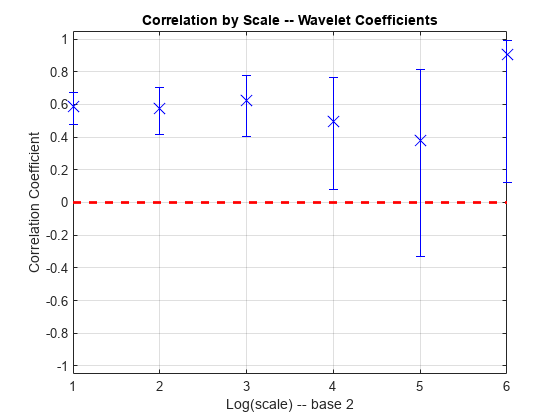modwtcorr
Multiscale correlation using the maximal overlap discrete wavelet transform
Syntax
Description
wcorr = modwtcorr(w1,w2)w1 and w2. wcorr is
an M-by-1 vector of correlation coefficients, where M is
the number of levels with nonboundary wavelet coefficients. If the
final level has enough nonboundary coefficients, modwtcorr returns
the scaling correlation in the final row of wcorr.
wcorrtable = modwtcorr(___,'table')wcorrtable designate
the type and level of each estimate. For example, D1 designates
that the row corresponds to a wavelet or detail estimate at level
1 and S6 designates that the row corresponds to
the scaling estimate at level 6. The scaling correlation is only computed
for the final level of the MODWT and only when there are nonboundary
scaling coefficients. You can specify the 'table' flag
anywhere after the input transforms w1 and w2.
You must enter the entire character vector 'table'.
If you specify 'table', modwtcorr only
outputs one argument.
[___] = modwtcorr(___,'reflection') reduces the
number of wavelet and scaling coefficients at each scale by half before computing the
correlation. Use this option only when you obtain the MODWT of w1 and
w2 were obtained using the 'reflection' boundary
condition. You must enter the entire character vector 'reflection'. If you
added a wavelet named 'reflection' using the wavelet manager, you must
rename that wavelet prior to using this option.
modwtcorr supports only unbiased estimates of the wavelet correlation.
For these estimates, the algorithm must remove the extra coefficients obtained using the
'reflection' boundary condition. Specifying the
'reflection' option in modwtcorr is identical to first
obtaining the MODWT of w1 and w2 using the default
'periodic' boundary handling and then computing the wavelet correlation
estimates.
modwtcorr(___) with no output
arguments plots the wavelet correlations by scale with lower and upper
confidence bounds. By default, the coverage probability is 0.95. Scales
with NaNs for the confidence bounds and the scaling correlation are
excluded.
Examples
Input Arguments
Output Arguments
References
[1] Percival, D. B., and A. T. Walden. Wavelet Methods for Time Series Analysis. Cambridge, UK: Cambridge University Press, 2000.
[2] Whitcher, B., P. Guttorp, and D. B. Percival. “Wavelet analysis of covariance with application to atmospheric time series.” Journal of Geophysical Research, Vol. 105, pp. 14941–14962, 2000.
[3] Benjamini, Y., and Yekutieli, D. “The Control of the False Discovery Rate in Multiple Testing Under Dependency.” Annals of Statistics, Vol. 29, Number 4, pp. 1165–1188, 2001.
Version History
Introduced in R2015b
